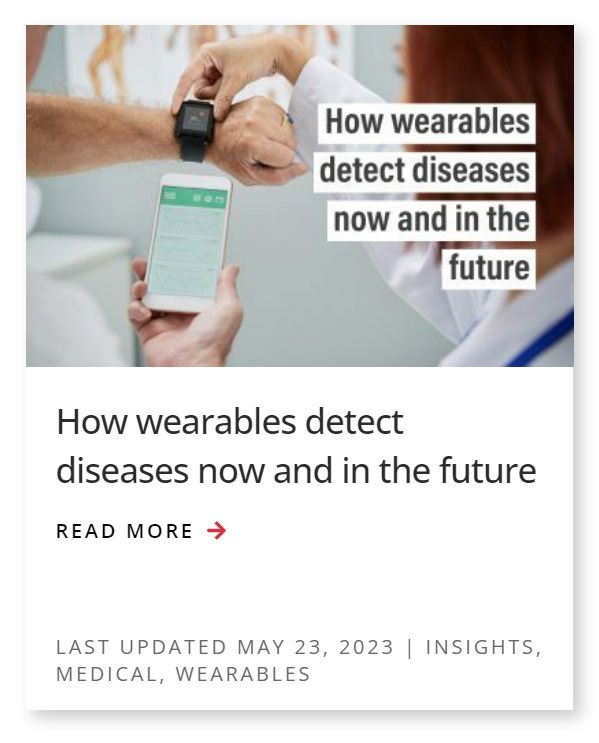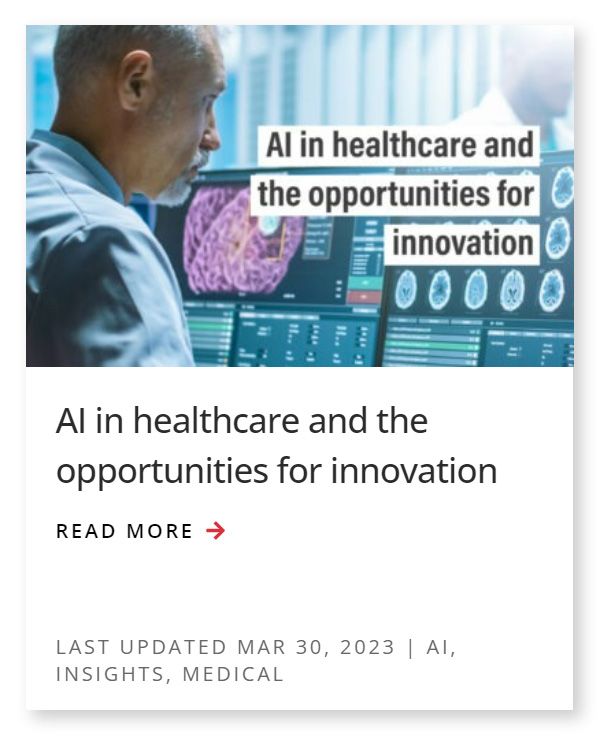We are an award winning product design consultancy, we design connected products and instruments for pioneering technology companies.
The Digital Health Revolution: How technology is transforming healthcare delivery
Reading time 9 mins
Key Points
- Digital health refers to the use of technology to improve healthcare delivery and patient outcomes
- Most common uses include telemedicine, wearables, and health apps
- Future advancements are likely to involve artificial intelligence for preventative medicine and genomics in personalised medicine
- Challenges to widespread adoption include data privacy, accessibility for everyone – especially in less developed countries, electronic waste pollution and the health risks arising from improper e-waste disposal
- These challenges present opportunities for innovation in sustainable design and emphasise Environmental, Social, and Governance (ESG) issues to effectively democratise the benefits of digital healthcare while reducing negative impacts.
Ready to start developing your new product?
Call us for a quote!
Ben Mazur
Managing Director
I hope you enjoy reading this post.
If you would like us to develop your next product for you, click here
Digital health refers to the use of information and communication technologies in medicine and other health professions to improve service delivery, patient outcomes, and the overall healthcare experience. The digital health future is already here and revolutionary in terms of how it’s radically transformed healthcare in ways that were unimaginable a few decades ago: it represents a complete shift in the way we perceive, administer, and receive healthcare. Key applications, innovations, and contraindications that we’ll explore further in this post include:
- Telemedicine
- Wearables
- Healthcare Apps
- Artificial Intelligence (AI) and Machine Learning (ML)
- Genomics and Precision Medicine
- Potential risks and challenges
A multi-pronged research project conducted by the Deloitte Center for Health Solutions and the Scottsdale Institute found that health systems consider digital capabilities as a path to fundamentally transforming their relationship with consumers. Essential to achieving this is a consumer-centric approach that focuses on improving the patient experience and newer forms of care delivery – the importance of which was highlighted during the pandemic.
When asked which digital technologies they were investing in to transform their healthcare systems, survey respondents (healthcare technology executives and industry leaders) reported investments in insights and analytics (76%), virtual health services (68%), and cloud (56%) as top priorities. In addition, most respondents agreed that digital health transformation is more than simply transferring paper processes to a digital environment: it’s a new way to deliver care and meet well-being needs while improving the performance of the institutions (e.g. hospitals and clinics) tasked with serving those needs.
Suggested articles
How are digital health technologies most commonly used?
1. Telemedicine, also known as telehealth, has been one of the most significant advancements in digital health. Telemedicine allows patients to receive healthcare services remotely through video consultations with healthcare providers. Telemedicine was particularly important during the COVID-19 pandemic, allowing patients to receive medical care while minimising the risk of exposure to the virus.
Top uses for telemedicine today include helping patients manage everyday conditions (e.g. allergies, flu, rashes), supplemental healthcare services (e.g. breastfeeding support, nutrition advice), and finding a ‘doctor-on-demand’.
2. Wearables are another digital health innovation that has recently gained popularity. Wearables are devices with built-in sensors worn on the body to track various metrics, such as heart rate, blood pressure, sleep patterns, and physical activity. These devices can help individuals monitor their health and make lifestyle changes to improve their well-being. Additionally, wearables can provide healthcare providers with valuable data to make more informed treatment decisions.
Check out our recent article on how wearables are used for disease detection for more insights.
3. Health apps are another digital health innovation that has recently gained popularity. Thousands of health apps are available that can help individuals track their health, manage chronic conditions, and communicate with healthcare providers. These apps can help individuals take a more active role in their healthcare and make more informed decisions about their health.
According to IQVIA Institute for Human Data Science’s 2021 trends report, more than 350,000 health apps are on the market. While most are geared towards general health or fitness, disease management apps (especially for mental health, diabetes, and cardiovascular diseases) are increasing.
4. Artificial intelligence (AI) and machine learning (ML) are also playing an increasingly important role in digital health. AI and machine learning algorithms can analyse large amounts of health data and identify patterns to improve healthcare delivery and patient outcomes. For example, AI algorithms can help healthcare providers identify patients at risk of developing certain conditions, such as diabetes or heart disease, and provide preventative interventions to reduce the risk.
We recently looked at how AI in healthcare creates opportunities for innovation, particularly in the fields of diagnostics and preventative medicine. When used with related technologies such as machine learning and computer vision, more opportunities for innovative technologies that improve patient outcomes are created. For example, Ambient Intelligence (electronic environments sensitive and responsive to people) in hospital waiting rooms could reduce patient waiting times and automate critical care support.
5. Genomics refers to the study of an individual’s DNA, and personalised medicine uses this information to tailor treatments to their specific genetic makeup. This approach could potentially improve treatment outcomes and reduce the risk of adverse reactions to medication.
The convergence of genomics and digital health technologies allows healthcare providers and medical practitioners to: provide decision support tools (e.g. individual predictions about disease risk), use conversational chatbots to scale the genetic counselling process, and increase healthcare efficiencies in conventional medicine by avoiding the ‘one-size-fits-all’ approach.
Digital healthcare challenges and obstacles
As with any technology, there are potential risks and challenges associated with digital health. One of the most significant challenges is ensuring that patients’ data privacy and security are protected. With the increasing amount of health data being generated and shared, it is essential to have robust security measures in place to prevent data breaches and protect patient privacy.
The World Health Organization’s Global Strategy on Digital Health (2020 – 2025) notes that in addition to account safety and ethical use, digital health technologies must be inclusive and equitable to reach their full value potential – especially in poor and developing countries. As digital health solutions become more prevalent, ensuring that they do not exacerbate existing healthcare disparities is essential.
Lastly, there is the question of managing the electronic waste that a booming tech market creates. Almost 50 million tons of electronic waste is generated annually, making it the fastest-growing waste problem in the world. In addition, because the majority of this waste is improperly disposed of (i.e. buried, dumped, or burned), global health problems caused by electronic waste (congenital disabilities, nervous system damage, lung disease, liver failure, and kidney damage) are rising.
Can the digital health promise overcome its problems?
The digital health future is here, and while its promise and potential to truly transform healthcare are undeniable, so too are the challenges it faces. That being said, we remain confident that problems are ideal opportunities for further innovation, and solutions will be found. Particularly if the industries involved take their environmental, social, and governance (ESG) impact more seriously and place sustainable design at the heart of the digital technologies they’re developing.
What are your thoughts on digital health? Is there an innovation or opportunity you’re excited about that we didn’t mention? Please leave us a comment and let us know so we can put it on our radar!
Comments
Get the print version
Download a PDF version of our article for easier offline reading and sharing with coworkers.






0 Comments